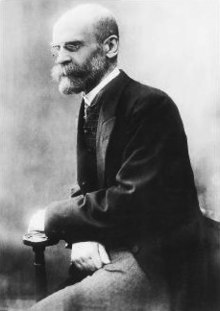Émile Durkheim - Simple English Wikipedia, the free encyclopedia
Émile Durkheim | |
|---|---|
 | |
| Born | David Émile Durkheim 15 April 1858 |
| Died | 15 November 1917 (aged 59) |
| Nationality | French |
| Alma mater | École Normale Supérieure |
| Known for | Sacred–profane dichotomy Collective consciousness Social fact Social integration Anomie Collective effervescence |
| Scientific career | |
| Fields | Philosophy, sociology, education, anthropology, religious studies |
| Institutions | University of Paris, University of Bordeaux |
| Influences | Immanuel Kant, René Descartes, Plato, Herbert Spencer, Aristotle, Montesquieu, Jean-Jacques Rousseau, Auguste Comte. William James, John Dewey, Fustel de Coulanges, Jean-Marie Guyau, Charles Bernard Renouvier, John Stuart Mill |
| Influenced | Marcel Mauss, Claude Lévi-Strauss, Talcott Parsons, Maurice Halbwachs, Lucien Lévy-Bruhl, Bronisław Malinowski, Fernand Braudel, Pierre Bourdieu, Charles Taylor, Henri Bergson, Emmanuel Levinas, Steven Lukes, Alfred Radcliffe-Brown, E. E. Evans-Pritchard, Mary Douglas, Paul Fauconnet, Robert N. Bellah, Ziya Gökalp, David Bloor, Randall Collins, Neil Smelser[1] |
David Émile Durkheim (April 15, 1858 – November 15, 1917) was a French sociologist. He is known for his contributions to sociology and anthropology. He is considered as one of the founding fathers of sociology. He thought that sociology should be scientific.
Life[change | change source]
Durkheim was born in the eastern French province of Lorraine. He studied at École Normale Supérieure. He made contributions on topics such as education, crime, religion, suicide, and many other topics related to sociology.
Durkheim died in Paris, aged 59.
Related pages[change | change source]
Other websites [change | change source]
References[change | change source]
- ↑ Alexander, Jeffrey C.; Marx, Gary T.; Williams, Christine L. (2004). "Trust as an Aspect of Social Structure". In Alexander, Jeffrey C.; Marx, Gary T.; Williams, Christine L. (eds.). Self, Social Structure, and Beliefs: Explorations in Sociology. Berkeley, California: University of California Press. pp. 145–146. ISBN 978-0-520-24137-4.


 French
French Deutsch
Deutsch